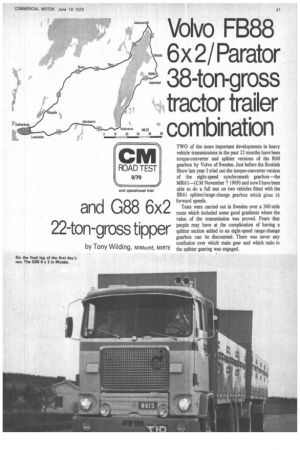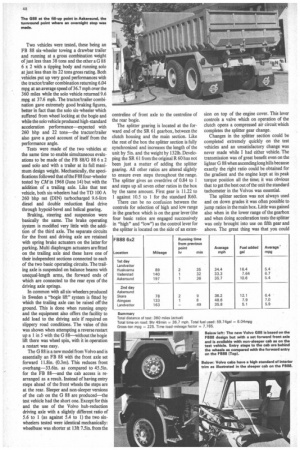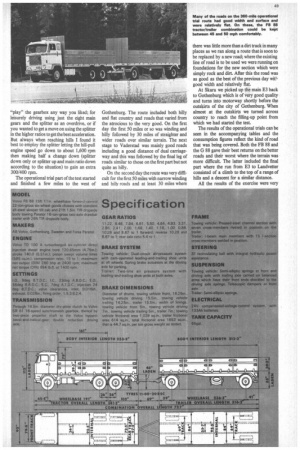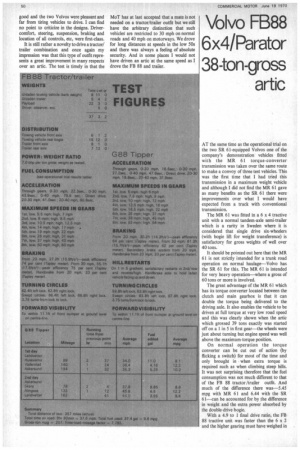Volvo FB88 6x 2/ Parator 38-ton-gross tractor trailer
Page 47

Page 48

Page 49

Page 50

If you've noticed an error in this article please click here to report it so we can fix it.
0,0 combination
Two vehicles were tested, these being an FE 88 six-wheeler towing a drawbar trailer and running at a gross combination weight of just less than 38 tons and the other a G 88 6 x 2 with a tipping body and running solo at just less than its 22 tons gross rating. Both vehicles put up very good performances with the tractor/trailer combination returning 6.04 mpg at an average speed of 36.7 mph over the 360 miles while the solo vehicle returned 9.6 mpg at 37.6 mph. The tractor/trailer combi nation gave extremely good braking figures, better in fact than the solo six-wheeler which suffered from wheel locking at the bogie and
while the solo vehicle produced high-standard acceleration performance-expected with 260 bhp and 22 tons-the tractor/trailer also gave a good account of itself from the performance angle.
Tests were made of the two vehicles at the same time to enable simultaneous evaluations to be made of the FB 88/0 88 6 x 2 used solo and with a trailer at its full maximum design weight. Mechanically, the specifications followed that of the F88 four-wheeler tested by CM in 1968 (June 14) but with the addition of a trailing axle. Like that test vehicle, both six-wheelers had the TD 100 A 260 bhp net (DIN) turbocharged 9.6-litre diesel and double reduction final drive through hypoid-bevel and helical gearing.
Braking, steering and suspension were basically the same. The brake operating system is modified very little with the addition of the third axle. The separate circuits for the front and driving axle are retained with spring brake actuaters on the latter for parking. Multi diaphragm actuaters are fitted on the trailing axle and these have one of their independent sections connected to each of the two basic operating circuits. The trailing axle is suspended on balance beams with unequal-length arms, the forward ends of which are connected to the rear eyes of the driving axle springs.
In common with all six-wheelers produced in Sweden a "bogie lift" system is fitted by which the trailing axle can be raised off the ground. This is done when running empty and the equipment also offers the facility to add load to the driving axle if required on slippery road conditions. The value of this was shown when attempting a reverse restart up a 1 in 5 with the G 88-without the bogie lift there was wheel spin, with it in operation a restart was easy.
The G 88 is a new model from Volvo and is essentially an FB 88 with the front axle set forward 11.8in. (0.3m). This reduces front overhang-33.6in. as compared to 45.5in. for the FB 88-and the cab access is rearranged as a result. Instead of having entry steps ahead of the front wheels the steps are at the rear. Sleeper and non-sleeper versions of the cab on the G 88 are produced-the test vehicle had the short one. Except for this and the use of the Volvo hub-reduction driving axle with a slightly different ratio of 5.6 to 1 (as against 5.4 to 1) the two sixwheelers tested were identical mechanically: wheelbase was shorter at 13ft 7.5 in. from the centreline of front axle to the centreline of the rear bogie.
The splitter gearing is located at the forward end of the SR 61 gearbox, between the clutch housing and the main section. Like the rest of the box the splitter section is fully synchronized and increases the length of the unit by 5in. and the weight by 132lb. Developing the SR 61 from the original R 60 has not been just a matter of adding the splitter gearing. All other ratios are altered slightly to ensure even steps throughout the range. The splitter gives an overdrive of 0.84 to I and steps up all seven other ratios in the box by the same amount. First gear is 11.22 to I against 10.5 to I for the standard R60.
There can be no confusion between the controls for selection of high and low range in the gearbox which is on the gear lever (the four basic ratios are engaged successively in "high" and "low") as the control lever for the splitter is located on the side of an exten
sion on top of the engine cover. This lever controls a valve which on operation of the clutch opens a compressed air circuit which completes the splitter gear change.
Changes in the splitter section could be completed extremely quickly on the test vehicles and an unsatisfactory change was never made while I had either vehicle. The transmission was of great benefit even on the lighter G 88 when ascending long hills because exactly the right ratio could be obtained for the gradient and the engine kept at its peak torque position all the time; it was obvious that to get the best out of the unit the standard tachometer in the Volvos was essential.
The splitter section was not always used and on down grades it was often possible to jump ratios in the main box. Little was gained also when in the lower range of the gearbox and when doing acceleration tests the splitter was only brought into use on fifth gear and above. The great thing was that you could "play" the gearbox any way you liked; for leisurely driving using just the eight main gears and the splitter as an overdrive, or if you wanted to get a move on using the splitter in the higher ratios to get the best acceleration. But always when reaching hills I found it best to employ the splitter letting the hill-pull engine speed go down to about 1,600 rpm then making half a change down (splitter down only or splitter up and main ratio down according to the situation) to gain an extra 300/400 rpm.
The operational trial part of the test started and finished a few miles to the west of
Gothenburg. The route included both hilly and flat country and roads that varied from the atrocious to the very good. On the first day the first 50 miles or so was winding and hilly followed by 30 miles of straighter and wider roads over similar terrain. The next stage to Vaderstad was mainly good roads including a good distance of dual carriageway and this was followed by the final leg of roads similar to those on the first part but not quite as hilly.
On the second day the route was very difficult for the first 50 miles with narrow winding and hilly roads and at least 30 miles where
there was little more than a dirt track in many places as we ran along a route that is soon to be replaced by a new road; where the existing line of road is to be used we were running on foundations for the new section which were simply rock and dirt. After this the road was as good as the best of the previous day with good width and relatively fiat.
At Skara we picked up the main E3 back to Gothenburg which is of very good quality and turns into motorway shortly before the outskirts of the city of Gothenburg. When almost at the outskirts we turned across country to reach the filling-up point from which we had started the test.
The results of the operational trials can be seen in the accompanying tables and the consumption figures reflect the kind of road that was being covered. Both the FB 88 and the G 88 gave their best returns on the better roads and their worst where the terrain was more difficult. The latter included the final part where the run from E3 to Landvetter consisted of a climb to the top of a range of hills and a descent for a similar distance.
All the results of the exercise were very
good and the two Volvos were pleasant and far from tiring vehicles to drive. I can find no point to criticize in the designs. Drivercomfort, steering, suspension, braking and location of all controls, etc, were first-class.
It is still rather a novelty to drive a tractor/ trailer combination and once again my impression was that this type of outfit represents a great improvement in many respects over an artic. The test is timely in that the MoT has at last accepted that a mate is not needed on a tractor/trailer outfit but we still have the arbitrary distinction that such vehicles are restricted to 30 mph on normal roads and 40 mph on motorways. We drove for long distances at speeds in the low 50s and there was always a feeling of absolute security. And in some places I would not have driven an artic at the same speed as I drove the FB 88 and trailer.


























































































































